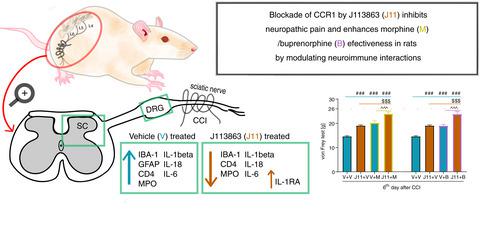当前位置:
X-MOL 学术
›
Immunology
›
论文详情
Our official English website, www.x-mol.net, welcomes your
feedback! (Note: you will need to create a separate account there.)
The blockade of CC chemokine receptor type 1 influences the level of nociceptive factors and enhances opioid analgesic potency in a rat model of neuropathic pain.
Immunology ( IF 4.9 ) Pub Date : 2020-02-05 , DOI: 10.1111/imm.13172 Katarzyna Pawlik 1 , Anna Piotrowska 1 , Klaudia Kwiatkowski 1 , Katarzyna Ciapała 1 , Katarzyna Popiolek-Barczyk 1 , Wioletta Makuch 1 , Joanna Mika 1
Immunology ( IF 4.9 ) Pub Date : 2020-02-05 , DOI: 10.1111/imm.13172 Katarzyna Pawlik 1 , Anna Piotrowska 1 , Klaudia Kwiatkowski 1 , Katarzyna Ciapała 1 , Katarzyna Popiolek-Barczyk 1 , Wioletta Makuch 1 , Joanna Mika 1
Affiliation

|
A growing body of evidence has indicated that the release of nociceptive factors, such as interleukins and chemokines, by activated immune and glial cells has crucial significance for neuropathic pain generation and maintenance. Moreover, changes in the production of nociceptive immune factors are associated with low opioid efficacy in the treatment of neuropathy. Recently, it has been suggested that CC chemokine receptor type 1 (CCR1) signaling is important for nociception. Our study provides evidence that the development of hypersensitivity in rats following chronic constriction injury (CCI) of the sciatic nerve is associated with significant up-regulation of endogenous CCR1 ligands, namely, CCL2, CCL3, CCL4, CCL6, CCL7 and CCL9 in the spinal cord and CCL2, CCL6, CCL7 and CCL9 in dorsal root ganglia (DRG). We showed that single and repeated intrathecal administration of J113863 (an antagonist of CCR1) attenuated mechanical and thermal hypersensitivity. Moreover, repeated administration of a CCR1 antagonist enhanced the analgesic properties of morphine and buprenorphine after CCI. Simultaneously, repeated administration of J113863 reduced the protein levels of IBA-1 in the spinal cord and MPO and CD4 in the DRG and, as a consequence, the level of pronociceptive factors, such as interleukin-1β (IL-1β), IL-6 and IL-18. The data obtained provide evidence that CCR1 blockade reduces hypersensitivity and increases opioid-induced analgesia through the modulation of neuroimmune interactions.
中文翻译:

在神经性疼痛大鼠模型中,CC 趋化因子受体 1 型的阻断会影响伤害感受因子的水平并增强阿片类药物的镇痛效力。
越来越多的证据表明,激活的免疫细胞和神经胶质细胞释放伤害性因子(例如白细胞介素和趋化因子)对于神经性疼痛的产生和维持具有至关重要的意义。此外,伤害性免疫因子产生的变化与阿片类药物治疗神经病的疗效较低有关。最近,有人提出 CC 趋化因子受体 1 型 (CCR1) 信号传导对于伤害感受很重要。我们的研究提供的证据表明,坐骨神经慢性压迫性损伤(CCI)后大鼠超敏反应的发生与脊髓中内源性 CCR1 配体(即 CCL2、CCL3、CCL4、CCL6、CCL7 和 CCL9)的显着上调有关。脊髓和背根神经节 (DRG) 中的 CCL2、CCL6、CCL7 和 CCL9。我们发现单次和重复鞘内注射 J113863(CCR1 拮抗剂)可减轻机械和热过敏。此外,重复给予 CCR1 拮抗剂可增强 CCI 后吗啡和丁丙诺啡的镇痛特性。同时,重复施用 J113863 降低了脊髓中的 IBA-1 以及 DRG 中的 MPO 和 CD4 的蛋白水平,从而降低了促伤害感受因子的水平,例如白介素-1β (IL-1β)、IL- 6和IL-18。获得的数据证明,CCR1 阻断可通过调节神经免疫相互作用来降低超敏反应并增加阿片类药物诱导的镇痛作用。
更新日期:2020-03-26
中文翻译:

在神经性疼痛大鼠模型中,CC 趋化因子受体 1 型的阻断会影响伤害感受因子的水平并增强阿片类药物的镇痛效力。
越来越多的证据表明,激活的免疫细胞和神经胶质细胞释放伤害性因子(例如白细胞介素和趋化因子)对于神经性疼痛的产生和维持具有至关重要的意义。此外,伤害性免疫因子产生的变化与阿片类药物治疗神经病的疗效较低有关。最近,有人提出 CC 趋化因子受体 1 型 (CCR1) 信号传导对于伤害感受很重要。我们的研究提供的证据表明,坐骨神经慢性压迫性损伤(CCI)后大鼠超敏反应的发生与脊髓中内源性 CCR1 配体(即 CCL2、CCL3、CCL4、CCL6、CCL7 和 CCL9)的显着上调有关。脊髓和背根神经节 (DRG) 中的 CCL2、CCL6、CCL7 和 CCL9。我们发现单次和重复鞘内注射 J113863(CCR1 拮抗剂)可减轻机械和热过敏。此外,重复给予 CCR1 拮抗剂可增强 CCI 后吗啡和丁丙诺啡的镇痛特性。同时,重复施用 J113863 降低了脊髓中的 IBA-1 以及 DRG 中的 MPO 和 CD4 的蛋白水平,从而降低了促伤害感受因子的水平,例如白介素-1β (IL-1β)、IL- 6和IL-18。获得的数据证明,CCR1 阻断可通过调节神经免疫相互作用来降低超敏反应并增加阿片类药物诱导的镇痛作用。











































 京公网安备 11010802027423号
京公网安备 11010802027423号